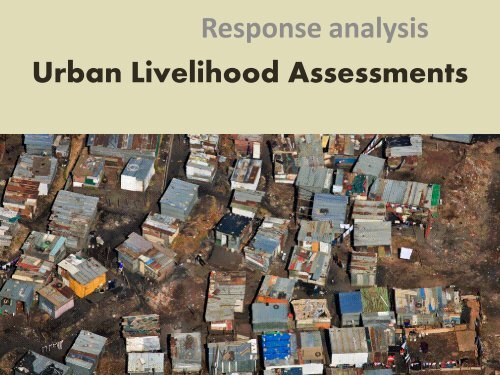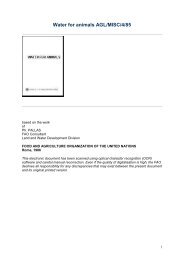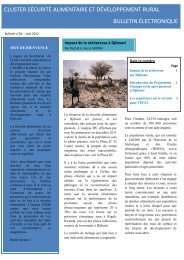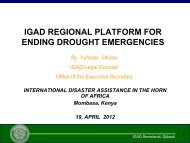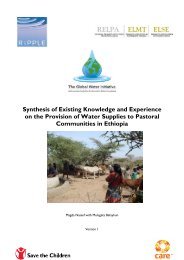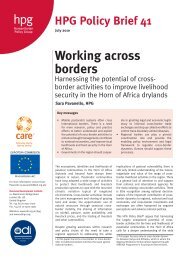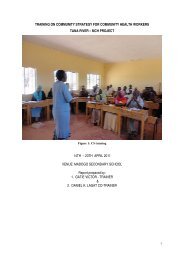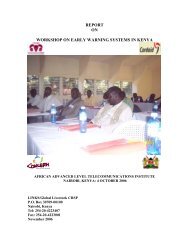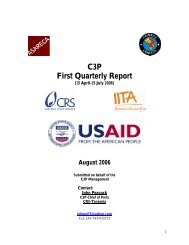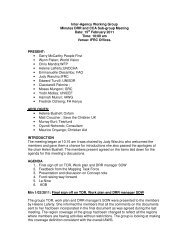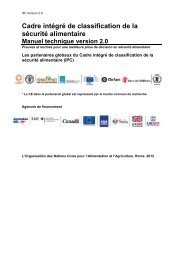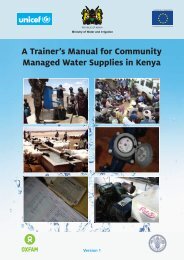Urban livelihood assessments - Disaster risk reduction
Urban livelihood assessments - Disaster risk reduction
Urban livelihood assessments - Disaster risk reduction
You also want an ePaper? Increase the reach of your titles
YUMPU automatically turns print PDFs into web optimized ePapers that Google loves.
Somali Shillings per year (in ‘000s)Annual expenditure of very poor and poor households (2007-08)Very poorhouseholdsspent about$113 permonthfor a familyof 6 people.70000600005000040000othergiftsclothessocial servicesThey could notafford to sendkids to formalschool, only tokoranic school(included in‘socialservices’).3000020000100000Very PoorPoorwaterrentHH itemsnon-staple foodstaple food‘Staple food’ includes: sorghum, rice, wheat flour, pasta‘Non-staple food’ includes: sugar, oil, and small quantities of vegetables (onions,tomatoes, potatoes), pulses, meat, milk powder, salt, tea leaves‘Household items’ includes: soap, firewood, kerosene, rent
The Framework for Outcome AnalysisVulnerability Profile/Baseline(The context)+Monitoring System(The changes)On-going Analysis of Situation(The outcome)2. Method and steps
OUTCOME ANALYSISWe start byunderstanding howhouseholds normallylive….
BASELINE AND SHOCK ANALYSIS…then we incorporate theimpact of a change….
BASELINE AND SHOCK ANALYSIS…and finally look at howpeople might copeThe analysis suggests that post-shock,households will not be able to maintaintheir normal <strong>livelihood</strong> assets withoutassistance.Livelihoods Protection ThresholdGapSurvival Threshold
<strong>Urban</strong> Analysis – poor household inMukuru Kwa Ruben• 55% of the pop., rent houses, dirt floor, noelectricity. HH size 6-7, single headed• Food access – purchase 90-95% of food needs(74% of this are cereals)• Economic activities – unskilled casual labour inindustrial areas, kiosks, hawkers, porters –income range Ksh 40,000 – 100,000 per annum
Impact on urban poor – Mukuru Kwa RubenScenario - 50% price increaseImpact on food sources120%Impact on expenditureResponse to shockGap = 6,000-7000/-100%Rural food1500080%60%40%20%Purchase - NonstaplePurchase - StaplemaizePurchase - Staplemaize meal1000050000Increased incomeIncreased expenses0%Baseline Shock ImpactLow er expenses - non stapleAdditional income - giftLow er expenses - otherStaple gapThe impact of the shock will causehouseholds to have a 40% food deficitbefore copingThey cope with increased expenditure onstaples by:• reducing number of meals/day• reducing expenditure on non- staple,social services & fuel• relying on gifts
Implications of coping – Price increase• Expand income by engaging in negative copingstrategies - prostitution, brewing, theft• Reduce quality of diet & # of meals – reduceexpenditure on sugar, milk & oil (50%) andvegetables• Reduce expenditure on soap, fuel & clothesetc (50%)• Reduce expenditure on accessing socialservices – health, education, water• Rely on gifts from rural home
Using HEA baseline information to analyze the effects of changeIf we had projected needs for 2008-09 at the end of 2007-08, what would the ‘problem’have looked like?PRICESItem Jul-Sep 08 Jul-Sep 07 Prob spec.sorghum 31483 6500 484%rice 41967 9583 438%wheat flour 39133 10417 376%labour 61333 49167 125%exchange rate 37068 20713 179%sugar 20800 11417 182%oil 69433 21500 323%firewood 11667 6250 187%cowpeas 51400 10000 514%milk 38133 23458 163%petrol 33083 13708 241%diesel 41650 13333 312%Staple foodUnskilled labourwage rate
Using HEA baseline information to analyze the effects of changeAssuming everything else unchanged (quantity of work), and using the change in exchangerate as a proxy for general inflation, this is the scenario analysis for very poor households:
Using HEA baseline information to analyze the effects of changeThese graphicssummarise theinformation fromthe previous slideThe thresholdswere defined asclosely as possibleto the existingFSNAU minimumfood and nonfoodbaskets fornorthern urbanareasIn this example,‘curr.year’ in thegraphics is theretrospectiveanalysis of 2008-09.
MonitoringWhat to monitor?Access to food – diet diversity andexpenditure on food basketAccess to non-food needsAsset Ownership (financial assets;productive assets; domestic assets,housing , etc.)Income (sources, and number ofincome earners per HH)Livestock production in areaCoping: % of HHs employing moderateand severe coping strategiesCivil insecurityMalnutrition rates and underlying causesAccess to basic services, sanitation & cleanwaterIncomes in small business (petty trade) sectorMarket data: Inflation, purchasing Power(terms of trade between labour wage andcereals), Labour availabilityFlows of trade into urban area (exports andimports)Business licenses issued by Municipality bysectorIDP concentration
<strong>Urban</strong> <strong>assessments</strong> & documentation<strong>Urban</strong> <strong>livelihood</strong> <strong>assessments</strong>• FSNAU/FEWS NET/Somalia Bosasso(2007/8), Baidoa (2008), Galkayo• FSNAU & SCUK - Beletweyne (2003)and Hargeisa (2006)• FEWS-NET Djibouti (2003)• SCUK – Mukuru Kwa Ruban, Kisumu,Kenya (2003)• SCUK – <strong>Urban</strong> & peri-urbanMandera & Garissa (2007)• Comprehensive Food Security andVulnerability Analysis and NutritionAssessment Kenya, KFSSG – Gov’t,WFP, FAO, FEWS-NET (2010)• Planned urban <strong>assessments</strong> – Juba,Lodwar, KinshasaDocumentation• FAO factsheets• ftp://ftp.fao.org/docrep/fao/011/ak003e/ak003e12.pdf• ftp://ftp.fao.org/docrep/fao/011/i0267e/i0267e03.pdf• IASC meeting Humanitarian Challenges in <strong>Urban</strong> AreasRG Strategy• http://www.fao.org/fileadmin/templates/FCIT/PDF/IASC_<strong>Urban</strong>_Humanitarian_Strategy.pdf• IFRC World <strong>Disaster</strong> report 2010 /urban <strong>risk</strong>• http://www.ifrc.org/Global/Publications/disasters/WDR/wdr2010/WDR2010-full.pdf• Cities and climate change 2011 / UN HABITAT• http://www.unhabitat.org/pmss/listItemDetails.aspx?publicationID=3086• The <strong>Urban</strong> Challenge & We’re not in the field anymore,27 th ALNAP meeting (January 2012)• http://www.alnap.org/events/27th.aspx• Food for the Cities position paper “Food, Agriculture andCities”• ftp://ftp.fao.org/docrep/fao/011/ak003e/ak003e12.pdf• Tufts University/Feinstein Life n Town• http://sites.tufts.edu/feinstein/2012/life-in-townmigration-from-rural-karamoja-to-moroto-and-mbale


